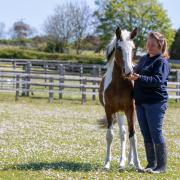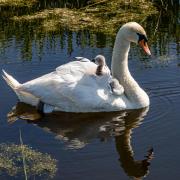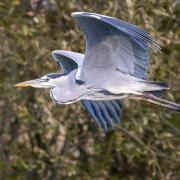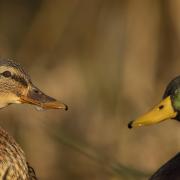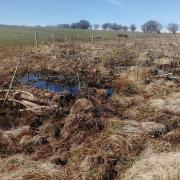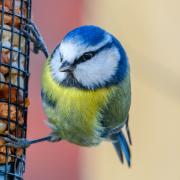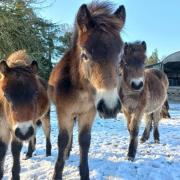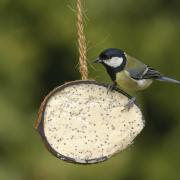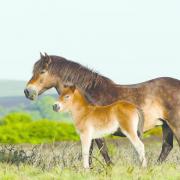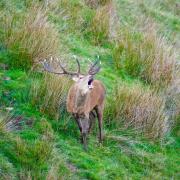The RSPB's Tony Whitehead describes the successful return of wild cranes to the Somerset Levels and Moors
After an absence of over 400 years, these elegant waterbirds have returned to Somerset courtesy of the Great Crane Project, a unique partnership between the Wildfowl & Wetlands Trust, Pensthorpe Conservation Trust and the RSPB. The project started life as an ambitious idea to give cranes a helping hand to re-establish themselves in the UK. In medieval times they were reasonably common but because of land drainage, exacerbated by hunting, they died out as a widespread breeding bird in the 17th century.For a while there’s been a small population in East Anglia, but as the majority of these birds show little or no sign of moving it was decided to search for a suitable place further west to reintroduce them. The Somerset Levels and Moors, with their damp pastures and reed-lined ditches, fitted the bill perfectly.The birds for the reintroduction come from Germany, from a population that can easily accommodate a few birds being re-homed. Here, in the east of the country, the birds nest in a mixture of open and forested swamps. In April a small UK conservation team met up with German colleagues to collect the first eggs.
This is challenging work. The eggs are fragile and the terrain is difficult. Imagine wading up to your waist in a forested swamp carrying an egg that will not stand being mishandled. But thanks to the experience of the avicultural experts, combined with the local knowledge of the German conservationists, the job was completed without a hitch. Well, almost. The safest and quickest way to get the eggs back to the UK is to fly them. But April saw the arrival of the infamous ash cloud and flying was out of the question. Instead, the team had to drive them from Germany to Gloucestershire non-stop, with the eggs carefully protected in a portable incubator. It was quite a trip, but finally, late on St George’s Day, the eggs were transferred safely to a purpose-built facility at Slimbridge.The following day, to much celebration, the first crane hatched. Over the next few weeks, and following a second trip to Germany, the Great Crane Project had 24 young cranes. Without their real parents to feed, support and guide them, the cranes are given human parents – Amy and Roland. Cranes, like all birds, do not have huge brains! They are creatures of instinct and will form strong bonds with whoever feeds them. The last thing the project wanted was the fledglings to view humans as actual crane parents. Imagine the problems this would bring the birds in later life! To avoid this ‘imprinting’ as it is known, Amy and Roland had to disguise themselves. Fortunately, nothing elaborate is required for our bird brains – a simple grey coverall will do. Spring turned to summer, and small cranes grew into big cranes. The rearing facility at Slimbridge became a ‘crane school’ and the birds spent their days learning what it’s like to be a crane, and learning to associate with other cranes.’ They started to develop as individuals. While some birds were clearly dominant, others were submissive, one or two were loners, and some were a little clingy towards their human parents. And, sadly, of the 24 birds, three did not make it through this stage. Despite the most professional care and attention, in any natural population some young birds are not going to make it. But the project took some solace from the fact that mortality in this group was significantly lower than it would have been in the wild.In early August, 21 birds said their farewells to the crane school and moved to the Somerset Levels and Moors. Here they entered the ‘crane academy’, a secret facility designed to acclimatise them to their new surroundings. At the academy the birds continued to make good progress. By late August they were ready to take their first steps into the wild. With some trepidation, the gates were opened and the birds were led out on daily walks with Amy and Roland. Up to this stage their ‘parents’ could teach them everything, but now there was one thing they simply had to do by themselves, a thing that no human could teach them; they needed to learn how to fly.Here instinct and genetics kicked in, and very soon the birds were aloft and making their first flights. Some encouragement was needed, and for some it had to be pointed out that flying over a ditch was probably preferable to walking through it. The birds soon got the idea and for the first time in 400 years a big flock of wild cranes were seen above the Somerset Levels and Moors.It takes a little while for cranes to reach breeding maturity, but it is hoped that by 2015 this first wave of birds will be nesting. Between now and then there will be more trips to Germany and the flock will increase in size year-on-year. It’s ambitious. It’s at the very leading edge of conservation science, but within ten years everyone is confident that cranes will once again be a common site in Somerset and will spearhead recolonisation further afield. For more information on the Great Crane Project, and to report your own sightings of the birds, visit thegreatcraneproject.org.uk The Great Crane Project is a partnership between the Wildfowl & Wetlands Trust, the RSPB and Pensthorpe Conservation Trust, with major funding from Viridor Credits Environmental Company.





